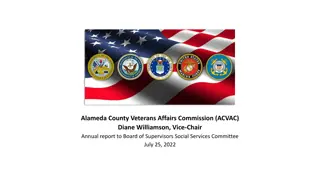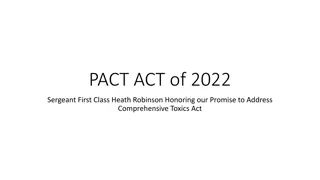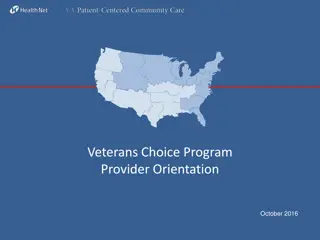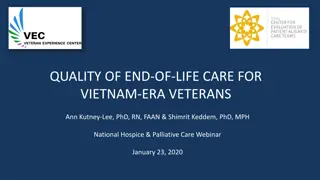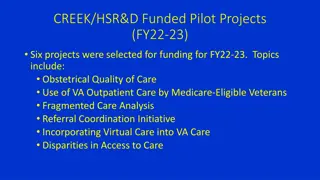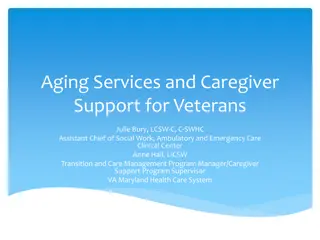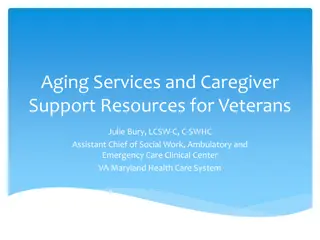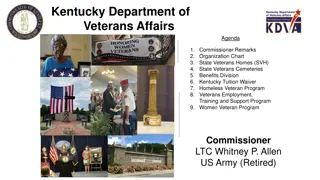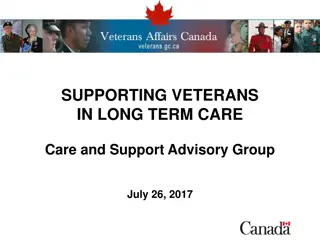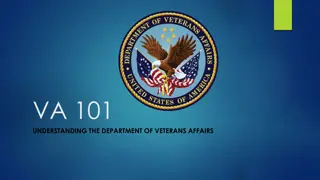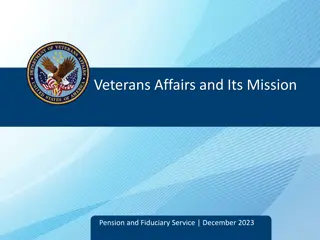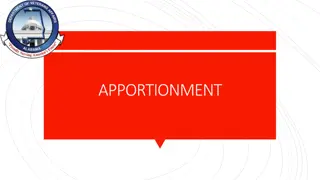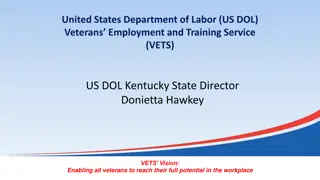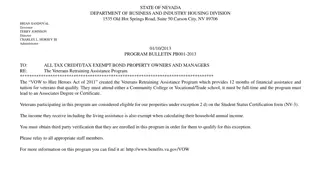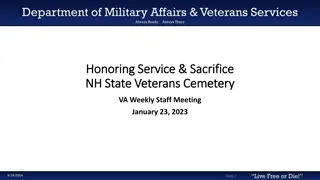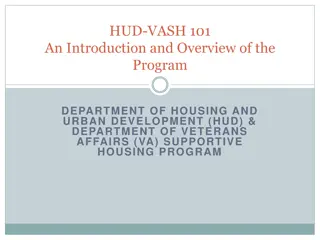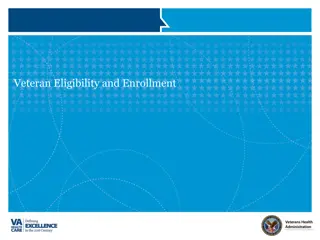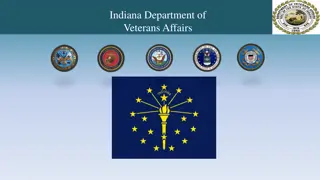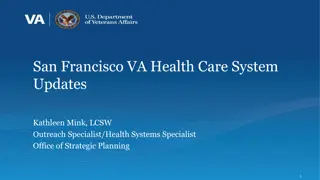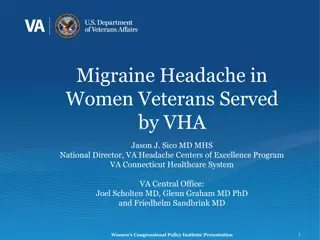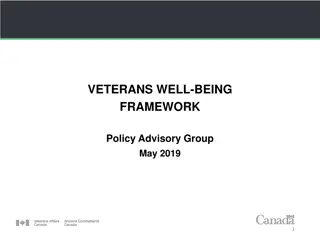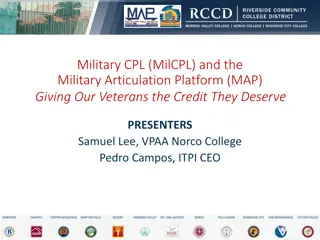Expansion of Health Care Eligibility for Toxic-Exposed Veterans
This Title expands the eligibility criteria for Toxic-Exposed Veterans in 38 U.S.C. 1710 by refining the definition of Vietnam-era herbicide-exposed veterans to include those who performed covered service in specified locations. It introduces three new categories of eligible veterans based on toxic exposure risk activities, service in Gulf and other locations, and participation in contingency operations. The Phase-in of Enrolment Eligibility Dates outlines discharge dates for Groups 1 & 2 until 2030, with the Secretary authorized to modify these dates if necessary. Additionally, the period for veterans to receive care at the VA following discharge from a Theater of Operation is extended to September 11, 2001.
Download Presentation

Please find below an Image/Link to download the presentation.
The content on the website is provided AS IS for your information and personal use only. It may not be sold, licensed, or shared on other websites without obtaining consent from the author. Download presentation by click this link. If you encounter any issues during the download, it is possible that the publisher has removed the file from their server.
E N D
Presentation Transcript
Title I Expansion of Health Care Eligibility This Title change and refine the definition of a Toxic-Exposed Veteran in 38 U.S.C. 1710 to include: Changes the definition of Vietnam-era herbicide-exposed veterans to mean Veterans who performed COVER SERVICE. Covered Service is: 1. Service in Republic of Vietnam (including Blue Water) from Jan 9, 1962 to May 7, 1975. 2. Service in Thailand at and US or Thai base from Jan 9, 1962 to June 30, 1976. 3. Service in Laos from Dec 1, 1965 to Sep 30, 1969. 4. Service in Cambodia at Mimot or Krek, Kampong Cham Province from April 16, 1969 to April 30, 1969. 5. Service in Guam or American Samoa (including territorial waters) from Jan 9, 1962 to July 31, 1980. 6. Service in Johnson Atoll or aboard a ship that visited from Jan 1, 1972 to Sep 30, 1977.
Includes as a Toxic-Exposed Veteran any Veteran who was exposed to Substance, Chemicals or Airborne Hazards which the Secretary of VA and Secretary of DOD have identified (this is mandated later in the law). Priority Group 6 Additions-and time table Three New Categories of eligible Veterans. Group 1: Veterans who Participated in Toxic Exposure Risk Activity . Toxic Exposure Risk Activity required a entry in a exposure tracking records system, or the Secretary to determines it is reasonably prudent to protect Veterans health. Exposure tracking records system- is any system, program or database used by the VA or DOD to track how Veterans or Service members have been exposed to occupational or environmental hazards, including Individual Longitude Exposure Records (this is a Joint VA DOD effort to start tracking any exposure a service member might have during their entire enlistment). Individual Longitudinal Exposure Record : https://www.publichealth.va.gov/exposures/publications/military-exposures/meyh-1/ILER.asp#:~:text=You%20will%20be%20hearing%20more,service%20member%20and%20future%20Veteran.
Group 2: Service in Gulf and other locations Veterans who served in Bahrain, Iraq, Kuwait, Oman, Qatar, Saudi Arabia, Somalia, or United Arab Emirates on or after Aug 2, 1990. Veterans who Served in Afghanistan, Djibouti, Egypt, Jordan, Lebanon, Syria, Yemen, Uzbekistan or any other location determined relevant by the Secretary on or after Sep 11, 2001. Group 3: Contingency Operation Veterans who deployed in support of a Contingency Operation. Contingency Operations are: Operation Enduring Freedom, Operation Freedom s Sentinel, Operation Iraqi Freedom, Operation New Dawn, Operation Inherent Resolve and Resolute Support Mission
Phase in of Enrolment Eligibility Dates: Oct 1, 2024: Groups 1 & 2 Discharged from Aug 2, 1990 to Sep 11, 2001. Oct 1, 2026: Groups 1 & 2 Discharged from Sep 11, 2001 to Dec 31, 2006. Oct 1, 2028: Groups 1 & 2 Discharged from Jan 1, 2007 to Dec 31, 2012. Oct 1, 2030: Groups 1 & 2 Discharged from Jan 1, 2013 to Dec 31, 2018. Oct 1, 2032: Group 3. The Secretary can modify these dates to earlier dates if deemed appropriate.
Certain Veterans of Combat and Other Matters. Expands the period of time that a Veteran who served in a Theater of Operation can receive care at the VA following discharge. Moves the beginning date back to Sep 11, 2001. Changes the period of time from 5 years to 10 years. For Veterans who served in a Theater of Operation from Sep 11, 2001 to Oct 1, 2013, that have not enrolled for care, can receive care for a 1 year period starting Oct 1, 2022. Expands Theater of Operation definition. To now include as proof the award of Armed Forces Expeditionary Medal, Service Specific Expeditionary Medal, Combat Era Specific Expeditionary Medal, Campaign Specific Medal, or any other combat theater award. Secretary must have a plan for outreach to Veterans by Dec 1, 2022 and report the number of enrollees to Congress by Jan 30, 2024. These changes go into effect October 1, 2022
Title III Improving the Establishment of Service Connection Process for Toxic-Exposed Veterans (post 1990) If a Veteran filed a claim with evidence of a disability and Toxic Exposure during service the Secretary may consider: Any exposure tracking record system. The totality of the circumstances of the Veterans service. The Secretary must establish and maintain a list with the DOD, that identifies the substance, chemicals and airborne hazards Veterans were exposed to. Must also determine whether to establish an end date to qualify for presumption. The Secretary must report to Congress every 2 years any changes to the exposure criteria or Presumption criteria.
Locations for Toxic Exposure (post 1990). Veterans who served in Bahrain, Iraq, Kuwait, Oman, Qatar, Saudi Arabia, Somalia, or United Arab Emirates on or after Aug 2, 1990. Veterans who Served in Afghanistan, Djibouti, Egypt, Jordan, Lebanon, Syria, Yemen, Uzbekistan or any other location determined relevant by the Secretary on or after Sep 11, 2001.
If the Veteran files a claim due to toxic exposure and the evidence if not sufficient for establishing Service Connection the VA must: Provide a adequate C&P exam: The medical opinion must consider the total potential exposure through all military deployments and; The synergistic, combined effect of all toxic exposure of each Veteran.
Title IV *** Presumptions of Service Connection*** Radiation locations Enewetak Atoll Clean up from Jan 1, 1977 to Dec 31, 1980. Palomares, Spain Responded to the recovery efforts Jan 17, 1966 to March 31, 1967. Thule, Greenland Responded to the recovery Jan 21, 1968 to Sep 25, 1968.
Herbicide (Agent Orange) locations Republic of Vietnam (including Blue Water) from Jan 9, 1962 to May 7, 1975. Thailand at a US or Thai base from Jan 9, 1962 to June 30, 1976. Laos from Dec 1, 1965 to Sep 30, 1969. Cambodia at Mimot or Krek, Kampong Cham Province from April 16, 1969 to April 30, 1969. Guam(including territorial waters) from Jan 9, 1962 to July 31, 1980. American Samoa (including territorial waters) from Jan 9, 1962 to July 31, 1980 Johnson Atoll or aboard a ship that visited from Jan 1, 1972 to Sep 30, 1977.
New Herbicide Presumptions: Monoclonal Gammopathy of Undetermined Significance (MGUS) A conditions in which abnormal proteins (M Proteins) is in a persons blood. Hypertension High Blood Pressure, at least over 140/90. Effective dates for conditions: MGUS On the date the PACT Act is enacted for DIC, Terminally Ill, Homeless, Extreme Financial Hardship, 85 or older, or able to demonstrate other sufficient cause. Oct 1, 2022 for all others. Hypertension On the date the PACT Act is enacted for DIC, Terminally Ill, Homeless, Extreme Financial Hardship, 85 or older, or able to demonstrate other sufficient cause. Oct 1, 2026 for all others. Nehmer applies.
Gulf War Illness Veterans Expands the period that a condition can manifest. Extends Period of Edibility permanently. Requires the VA to complete a Gulf War DBQ if a Veteran presents to a VAMC with one or more of the Gulf War Illness Symptoms. Expands the definition of Persian Gulf Veteran : To include Afghanistan, Israel, Egypt, Turkey, Syria and Jordan along with Southwest Asia service.
Burn Pit Conditions Asthma A condition in which a person's airways become inflamed, narrow and swell, and produce extra mucus, which makes it difficult to breathe. Chronic Bronchitis A long-term inflammation of the bronchi (the large tube that connects your trachea to your lungs). Chronic Obstructive Pulmonary Disease (COPD) A group of lung diseases that block airflow and make it hard to breathe. Constrictive Bronchiolitis or Obliterative Bronchiolitis A rare, irreversible, life-threatening form of lung disease that occurs when the small airway branches of the lungs are compressed and narrowed by scar tissue and inflammation. Emphysema A condition in which the air sacs of the lungs are damaged and enlarged. Granulomatous Disease A disorder which causes the immune system to be unable to protect from invaders such as bacteria and fungus.
Interstitial Lung Disease Progressive scarring of the lungs due to hazardous exposure. Pleuritis Inflammation of the lung lining and chest cavity. Pulmonary Fibrosis Lung disease caused by lung scarring and thickening over time. Sarcoidosis Condition that causes collections of inflammatory cells to grow in different parts of the body. Chronic Sinusitis Chronic inflammation of the cavities around the nasal passages. Chronic Rhinitis Chronic Irritation and swelling of the mucous membrane in the nose. Glioblastoma Malignant Tumor of the Brain or Spine.
Cancers Head Cancer of any type Neck Cancer of any type Respiratory Cancer of any type Gastrointestinal Cancer of any type Reproductive Cancer of any type Lymphoma Cancer of any type Lymphomatic Cancer of any type Kidney Cancer Brain Cancer Melanoma Pancreatic Cancer Any other Condition the Secretary determines Presumtive
Effective Dates of Burn Pit Conditions: On the date the PACT Act is enacted for DIC, Terminally Ill, Homeless, Extreme Financial Hardship, 85 or older, or able to demonstrate other sufficient cause. On the Date the PACT Act is enacted: Asthma, Respiratory Cancer, Brain Cancer, Constrictive Bronchiolitis or Obliterative Bronchiolitis, Emphysema, Granulomatous Disease, Interstitial Lung Disease, Pleuritis, Pulmonary Fibrosis, Sarcoidosis, Chronic Sinusitis, Chronic Rhinitis, Glioblastoma and any new condition the Secretary determines to be Presumptive. Oct 1, 2023: Chronic Bronchitis and Chronic Obstructive Pulmonary Disease. Oct 1, 2024: Head, Neck, Gastrointestinal, Reproductive, Lymphoma, Lymphomatic and Pancreatic Cancers. Oct 1, 2025: Kidney Cancer and Melanoma
Camp Lejeune Lawsuit Any Individual (Veteran, or person who resided, work or was otherwise exposed (including in utero)) or their legal representative, who was at Camp Lejeune for 30 days from Aug 1, 1953 to Dec 31, 1987, can bring legal action in the US District Court of Eastern North Carolina to obtain relief for any harm done by the exposure to the Camp Lejeune water. Burden of proof is on the party filing the action Must show there is sufficient proof that harm has a 50/50 causal relationship with exposure. OFFSET!!!!!!!! If a settlement is awarded and the party received VA, Medicare or Medicaid benefits for the same HARM related to the Camp Lejeune exposure, there is an offset. Meaning filing a law suit could suspend VA benefits.
Questions? Frank Morrow fmorrow@clermontcountyveterans.com 513-732-7363


